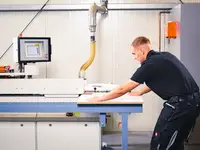In most businesses EVA hotmelt adhesive is used and fulfils the requirements reliably. However, OSTERMANN experts recommend PUR adhesive because of its clearly better adhesive qualities (water resistance, thinner bond line, higher bond strength). Many businesses are concerned about cleaning the machine after using PUR, but the hotmelt adhesive gluepot is easy to clean after cooling with the help of the blue cleaner. However, you must not forget to do this.
Special tip: It’s also possible without the cleaner. Carefully remove the PUR residue, run the leftover edging through, until there is no more adhesive on the roll and then apply EVA glue to edging again.
